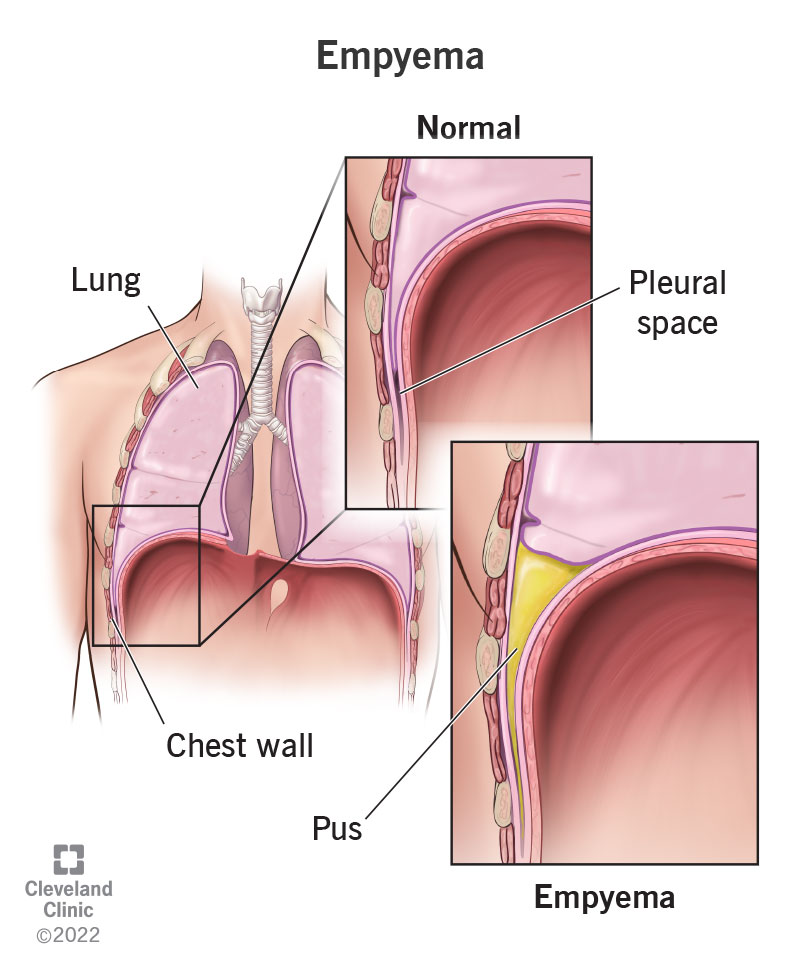Empyema is a condition that causes pus to develop in your pleural space. Pneumonia is the most common cause. A healthcare provider can diagnose empyema by listening to your lungs and ordering imaging and blood tests. Antibiotics treat most cases of empyema, but a provider may need to drain pus with a needle or through surgery.
Advertisement
Cleveland Clinic is a non-profit academic medical center. Advertising on our site helps support our mission. We do not endorse non-Cleveland Clinic products or services. Policy

Empyema is an infection in which pus develops in your pleural space.
Advertisement
Cleveland Clinic is a non-profit academic medical center. Advertising on our site helps support our mission. We do not endorse non-Cleveland Clinic products or services. Policy
Pus is a thick, discolored (white, yellow, pink or green) fluid that your body creates to help fight infection. It consists of white blood cells, dead tissue and bacteria.
Your pleural space is a hollow area (cavity) between your lungs and underneath your chest wall.
Without proper treatment, empyema can get worse and may be fatal. If you have symptoms of empyema, call a healthcare provider right away.
Other names for empyema include pyothorax and purulent pleuritis.
No, empyema isn’t a chronic obstructive pulmonary disease (COPD). COPD is an umbrella term for various lung diseases, including chronic bronchitis and emphysema. Healthcare providers are more likely to see infections such as empyema as a symptom in people with COPD than in people without COPD.
Anyone can get empyema. However, you’re more likely to get empyema if you:
Empyema isn’t common. There are about 32,000 cases of empyema in the United States each year.
Empyema symptoms are nonspecific and may include:
Advertisement
Empyema typically develops when an infection spreads from your lungs to the pleural space.
The most common cause of empyema is pneumonia. Other causes include:
Empyema typically develops about four to six weeks after bacteria enter your lungs.
No, empyema isn’t contagious. However, many of the infections that cause empyema are contagious, especially pneumonia and tuberculosis.
A healthcare provider can diagnose empyema. They’ll review your medical history and conduct a physical examination. They’ll also collect a fluid sample from around your lung.
If a provider suspects you have empyema, they’ll order tests to help confirm a diagnosis.
A healthcare provider may order the following tests to help diagnose empyema:
Yes, there’s a cure for empyema. Treatment includes removing pus from your pleural space and treating the infection, usually with antibiotics.
A provider will remove pus through thoracentesis in the early stages of empyema. They’ll use a thin needle to inject a local anesthetic into your skin and deeper tissue. They’ll then attach a larger needle/catheter device to withdraw the pus and drainage tubing to allow the pus to flow outside your body. If drainage isn’t enough, a provider may try to break up the pus through fibrinolytic therapy.
In the later stages of empyema, a provider may need to perform a more invasive procedure, such as surgically removing fibrous tissue (decortication), a thoracotomy or a video-assisted thoracic surgery (VATS).
A healthcare provider will prescribe antibiotics to treat mild cases of empyema. Examples include, but not limited to, the following:
Antibiotics typically take two to six weeks to work. If your provider prescribes antibiotics to treat empyema, it’s important to take your full course of antibiotics, even if you feel better. If you don’t, the cause of your empyema can come back and be more difficult to treat.
Advertisement
After thoracentesis, you may feel sore for a few days or up to a week.
More invasive treatment procedures may require four to six weeks of recovery.
Empyema isn’t common. Most cases don’t progress to later stages with early treatment. However, it can be fatal without proper treatment in 5% to 30% of people with empyema and other conditions (comorbidities). The mortality rate is about 40% in immunocompromised people who have empyema.
It’s important to see a healthcare provider if you have symptoms of empyema. If a provider prescribes antibiotics, finish the entire course so the infection doesn’t come back.
The best way to prevent empyema is to treat any lung infections quickly.
Pneumonia is an infection in one or both of your lungs. Its causes include bacteria, viruses and fungi. You can cough out infected phlegm if you have pneumonia.
Empyema is an infection in your pleural space. The bacteria that cause pneumonia can cause empyema. You can’t cough out pus if you have empyema. You must clear the pus with antibiotics, or a healthcare provider must drain it with a needle or surgery.
Advertisement
A lung abscess is an abnormal growth of dead tissue and pus within the lung itself. Pulmonary (lung) infections cause abscesses. Abscesses don’t move. Empyema is pus outside of the lung within the pleural space.
Pleural effusion is a build-up of excess fluid between the thin membranes of your lungs and pleural space. Another name for pleural effusion is water on the lungs.
A parapneumonic effusion is a type of pleural effusion. It develops as a result of pneumonia. It can progress to empyema.
Empyema is a condition in which you have pus in your pleural space. It usually causes symptoms that affect your chest and breathing. Though it’s not common, if a healthcare provider diagnoses empyema early, your chances of making a full recovery are good. However, empyema can be fatal if you don’t receive treatment or have other conditions.
Talk to a healthcare provider if you have trouble breathing or other symptoms that affect your chest. They can diagnose empyema, determine its cause and work with you to get the most effective treatment.
Advertisement
Breathing issues can affect your life in many ways. Cleveland Clinic’s respiratory therapy program treats your symptoms so you can feel better day to day.

Last reviewed on 10/05/2022.
Learn more about the Health Library and our editorial process.